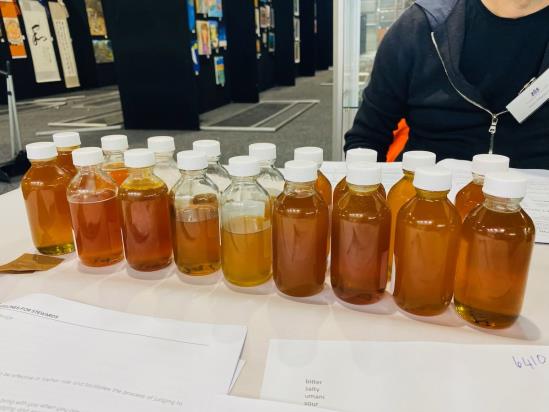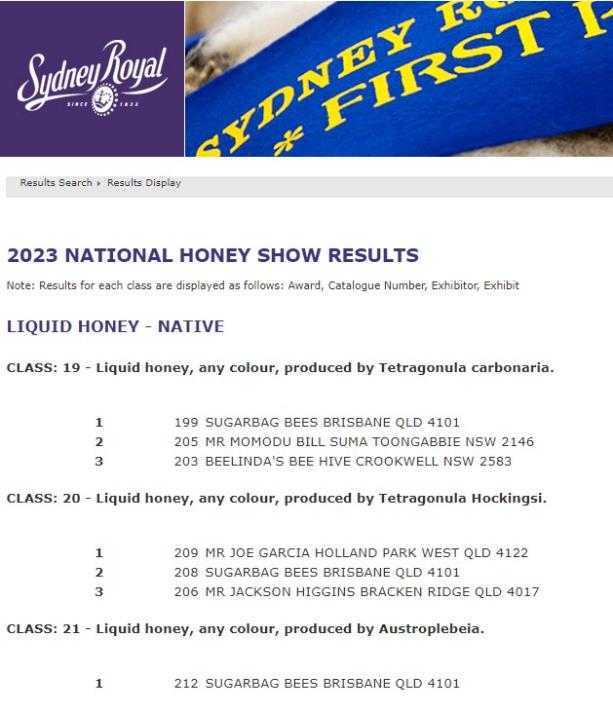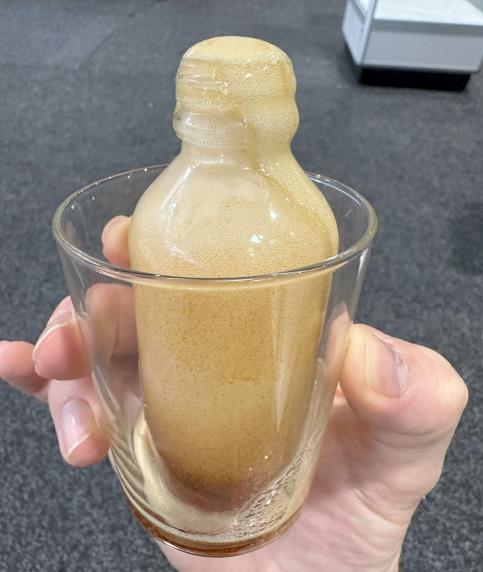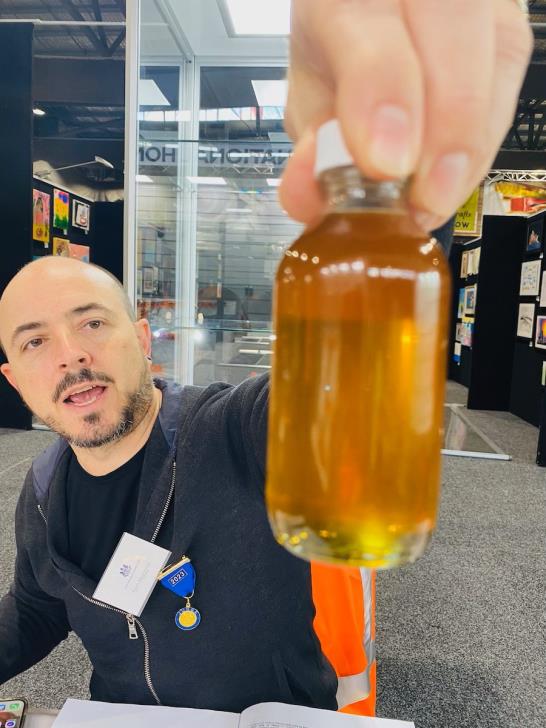It’s A Tough Job But Someone Has To Do It: Judging Our Native Bee Honey (Part 1)
A Reflection Series On Honey Judging At The Sydney Royal Easter Show’s National Honey Competition
Sam Higgins, ANBA Sydney Branch Member & Royal Agricultural Society (RAS) Native Bee Honey Judge
Our Competition History
Honey has been the subject of competition at the Sydney Royal Easter Show for over 150 years with the first Apiculture exhibit submitted in 1870. Yet, despite the prevalence of our own honey producing stingless native bees it was only in 2019 that our unique product first joined the National Honey Show.
In that inaugural year, Toby Smith, having joined the European honey judging process in 2018, conducted the first ever competitive judging of 18 entries across two classes of “Liquid Honey – Native” Class 19 – Tetragonula and Class 21 – Austroplebeia.
The judging process at the time borrowed significantly from that of European honey with a judge plus one steward assessing each entrant out of 100 points against six weighted criteria.
As Toby himself noted at the time on Facebook, “I used these criteria as best as I could for stingless bee honey, although they are not a perfect fit. I used common sense to interpret some of these in an appropriate form for stingless bee honey.”
The result of Toby’s efforts was a set of revised guidance across the six criteria published in the National Honey Show Schedule and applied to the 13 entries submitted in 2021 where Dan Smailes presided:
Flavour -The initial taste, secondary taste, and any lingering mouthfeel. Score out of 30
Aroma – The scent imparted immediately and soon after opening the bottle. Smells of mould and fermentation are undesirable. Score out of 25.
Clarity – A measure of contamination from, but not limited to, pollen, dirt, tree bark or propolis. Score out of 25.
Density – Moisture content, measured by a refractometer. Score out of 15.
Brightness – A measure of visible bubbles before opening the bottle. Score out of 5
During 2021 the entry process was also modified with the Royal Agricultural Society providing the standard 2 x 100ml bottles used in our competition to avoid inconsistencies in submission and ensure that no entry could be identified ensuring a fair and equitable contest.

My Transition From Competitor To Judge
In 2022 I was invited to replace Dan as judge. Having been a stingless bee keeper since 2010 and an entrant in both the 2019 and 2021 competition this was an amazing opportunity as few, if any of us, get to taste as much honey in one place at one time. Let alone honey sourced from up and down the east coast! It was a true privilege to even be asked.
It was also an especially exciting time for our native bee honey. Dean Haley’s book on the topic had just been published, raising interest within, and beyond, our native bee community and the Association’s Honey Committee had begun its work on formulating a food standard for our product. The show offered a unique opportunity to further explore the many questions raised through these activities.
I discussed the judging process with Dan, who himself had recommended that we split the 2021 competition into three classes by dividing the very different Carbonaria from Hockingsi. But the criteria published by Toby remained unchanged, with Dan noting that access to a refactometer was difficult and that as Toby has also suggested in his post-event review of 2019 flavour, aroma and clarity were the key criteria for comparing our honeys.
So, the honour fell to me in both 2022 of judging 25 honeys across the three classes and a total of 21 entries in 2023. During the past 2 years my steward was Patrice Newell of Elmswood Farm, who took over from Dani Lloyd-Prichard who is also a great supporter of our community. Patrice is not only a native bee fan, but importantly a European bee keeper, garlic farmer and olive oil producer and judge. These qualities have made Patrice an invaluable partner on the journey given her produce judging experience.
I also benefited this year from the feedback of renowned food reviewer and Royal National Agricultural and Industrial Association of Queensland (RNA) judge Jeremy Ryland who with support from Ian Driver presided over the Royal Queensland Show (Exhibition or Ekka) in 2022.
The 2023 Field And Results
As Toby noted in 2019, “There were some bloody sensational honeys, and a small handful of rather less pleasant honeys.” This has been true in both 2022 and 2023. Dan once said to me he had to get past the “smell of old socks” on more than one occasion during his 2021 judging! But this is a minor downside compared to the wonderful honey on offer each year.
Overall, 2023 was a very different year to 2022, much of the difference both in lower volume and flavours I attribute the very different climatic conditions – that is an extremely long period of wet weather in contrast to the drier conditions in the years prior.
The one and only Austroplebeia entry was fascinating to taste. It provided a pleasant aroma that was warm, bready and a complex scent that became sweeter once left opened which is a key step in the assessment of aroma. That is, we smell the immediately opened bottle and then allow each open bottle to rest for 10-15 minutes before assessing the aromas for a second time. This honey melted in your mouth with a butterscotch lolly sweetness and was smooth – completely free of the grainy mouth feel that accompanies the presence of pollen. Austroplebeia is a rarer honey and so this class has traditionally seen a smaller number of entries, but despite only one entry, this honey was an exceptional example of native bee honey from this species.

Hockingsi entries are also much fewer in the Royal Easter Show given their more traditional range further north. Indeed, all of these were submitted from Queensland. But despite the small group they were all fine examples too. All entries exhibited examples of flavour complexities and pleasant, lingering aromas. This group also had high clarity and near perfect brightness, assessed on the basis of very few bubbles around the top of the honey. The winning entry offered a sweet floral aroma with pleasant tangy notes that lingered. While its flavour was typical of the tension between sweet and sour of our Hockingsi honey this particular entry also had complex subtle buttery notes. It was very smooth on the mouth.
Sadly, half the Carbonaria entries did not meet the current requirements of 2 x 100mls filled to the collar of the bottles provided. These entries were scored but could not be considered for places.
I also noted that compared to entries in 2022, this year’s entries did not exhibit the full potential of flavours and many failed to produce a significant aroma at all with the more distinctive and complex citrus and floral flavours of our honeys seeming washed out or missing. Many of the entries were also grainy and this detracted from the flavour and mouth feel – an experience which when judged should be pleasant on the initial taste, the secondary taste and the lingering mouth feel. That said, the clarity of some honey in this class was exceptional. Although a small number were overly fermented with one bubbling over within minutes of opening – quite a spectacle to watch!

As with the other classes the placed entries were fine examples of this species, with the winner what I would describe as a classic Carbonaria honey: sweet, smooth and floral.
Next month I’ll explore in more detail the judging process itself and recommendations for changes to our approach for the National Honey Competition in 2024.

